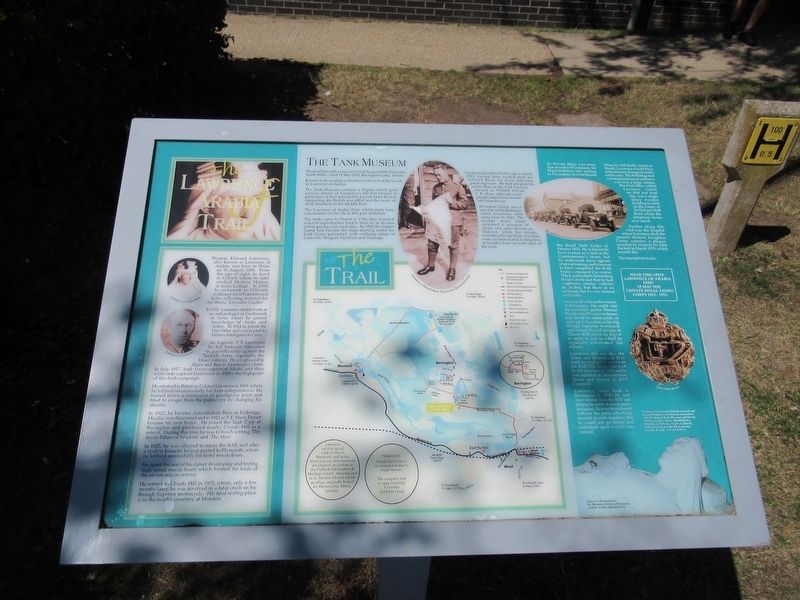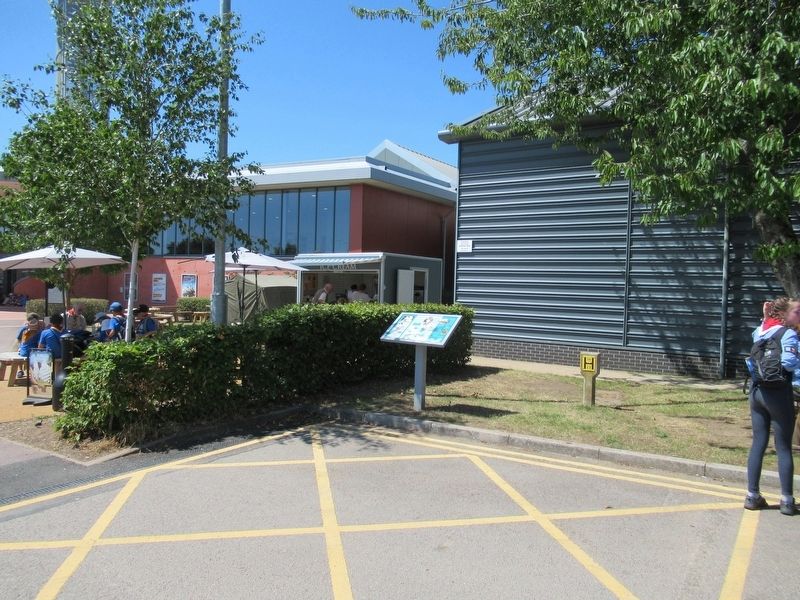Bovington in Dorset, England, United Kingdom — Northwestern Europe (the British Isles)
The Lawrence of Arabia Trail
— The Tank Museum —
Thomas Edward Lawrence; born 16 August 1888, Tremadoc, North Wales - died 19 May 1935, Bovington Camp, Dorset. Known to his mother as Ned but to the rest of the world as Lawrence of Arabia.
The Tank Museum contains a display which gives various details of Lawrence's life but focuses in particular on that remarkable period when he was supporting the British war effort and the cause of Arab liberation in the Middle East.
The Lawrence of Arabia Trail, which starts here, concentrates on his life in this part of Dorset.
The tanks came to Dorset in 1916; they required acres of unproductive land to train on, in an area where prying eyes were few. By 1918 Bovington Camp had become the main training centre for Tank Corps personnel, with outlying camps at Lulworth, Worgret, Sandford and Swanage.
Lawrence joined the Tank Corps in March 1923, having been evicted from his beloved Royal Air Force following press exposure. He had adopted the name Ross in the RAF but now attested as 7875698 Private T. E. Shaw although many people seem to have known who he really was.
Bovington Camp was a raw scar on the landscape when Lawrence first came here in 1923. The muddy main street contained a selection of shops and cafes known as Tintown, while the troops, including Private Shaw of course were accommodated in long lines of wooden huts on both sides of the road.
Thomas Edward Lawrence, also known as Lawrence of Arabia, was born in Wales on 16 August 1888. From the age of eight, he lived in Oxford, where he later studied Modern History at Jesus College. In 1909 he undertook an 1100-mile walking tour of Palestine and Syria, collecting material for his thesis, ‘Crusader Castles'.
In 1911, Lawrence started work as an archaeologist at Carchemish in Syria, where he gained knowledge of Arabs and Arabic. In 1914 he joined the War Office and was posted to Military Intelligence in Cairo.
As Captain T.E. Lawrence he led bedouin tribesmen in guerrilla raids against the Turkish Army, especially the Hejaz railway. He progressed to Major and then to Lieutenant Colonel. In July 1917 Arab forces captured Akaba and then went onto capture Damascus in 1918 – the highpoint of the Arab campaign.
He returned to Britain as Colonel Lawrence in 1918, where he lobbied unsuccessfully for Arab independence. He turned down a succession of prestigious posts and tried to escape from the public eye by changing his identity.
In 1922, he became Aircraftsman Ross at Uxbridge. His alias was discovered and in 1923 as T. E. Shaw, Dorset became his new home. He joined the Tank Corp at Bovington and purchased nearby Clouds Hill as a retreat. During this time he was to finish writing ‘The Seven Pillars of Wisdom’ and ‘The Mint.’
In 1925, he was allowed to rejoin the RAF, and after a spell in Karachi, he was posted to Plymouth, where he lobbied successfully for faster rescue boats.
He spent the rest of his career developing and testing high speed rescue boats which formed the basis of the air-sea rescue service.
He retired to Clouds Hill in 1935, where, only a few months later, he was involved in a fatal crash on his Brough Superior motorcycle. His final resting-place is in the nearby cemetery at Moreton.
As Private Shaw, Lawrence first served in B Company, 1st Depot Battalion, later moving to A Company in what became the Royal Tank Corps in October 1923. He is known to have worked as a clerk in the Quartermaster's Stores, but he underwent many rigours of recruit training and is known to have completed the Rolls Royce Armoured Car course. This is particularly interesting in view of the fact that he had employed similar vehicles in Arabia, but there is no evidence that he ever trained with tanks.
Lawrence had three diversions at Bovington. He could visit the venerable author Thomas Hardy at his Dorchester home, tear about the countryside, or even up to London on his big Brough Superior motorcycle and restore the old cottage at Clouds Hill which he hoped to retire to and in which he regularly entertained his friends.
Lawrence did not like the Army and throughout 1924 tried to engineer a return to the RAF. This finally bore fruit in the summer of 1925 and he was admitted as Aircraftsman Shaw and posted to RAF Cranwell.
Lawrence came back to Bovington in 1935. He had now retired from the RAF and planned to settle down in peace and quiet. As ever he reckoned without the press who hung around in such numbers that he could not go home and embarked upon a cycle tour instead.
When he did finally return in March, Lawrence would have noticed many changes from his earlier stay. The buildings had a more permanent air and there was even a large cinema. The Post Office, which Lawrence visited on that last fatal day, was a single storey wooden building located on the corner of Sir Richard Hull Road where the telephone boxes now stand.
Further along this road was the hospital where Lawrence died; the present Medical Reception entre contains a plaque, unveiled by General Sir John Hackett in March 1979, which 192 records this. The inscription reads;
Lawrence of Arabia
Died 19 May 1935
Private Royal Tanks
Corps 1923 – 1925
Topics. This memorial is listed in this topic list: War, World I.
Location. 50° 41.685′ N, 2° 14.552′ W. Marker is in Bovington, England, in Dorset. Memorial can be reached from the intersection of King George V Road and Linsay Road, on the left when traveling south. Located at The Tank Museum. Touch for map. Marker is in this post office area: Bovington, England BH20 6JG, United Kingdom. Touch for directions.
Other nearby markers. At least 8 other markers are within walking distance of this marker. Royal Tank Regiment Memorial Statue (a few steps from this marker); Household Cavalry and Royal Armoured Corps Memorial (a few steps from this marker); Challenger I Main Battle Tank (within shouting distance of this marker); The Kuwait Arena (within shouting distance of this marker); Tank Infantry Mark IV (within shouting distance of this marker); FV603B Armoured Personnel Carrier (within shouting distance of this marker); M4A1 Medium Tank Grizzly (about 150 meters away, measured in a direct line); Centurion Mark 12 (about 180 meters away). Touch for a list and map of all markers in Bovington.
Also see . . .
1. T. E. Lawrence on Wikipedia. (Submitted on September 21, 2018, by Michael Herrick of Southbury, Connecticut.)
2. The Tank Museum. (Submitted on September 21, 2018, by Michael Herrick of Southbury, Connecticut.)
3. The Tank Museum on Wikipedia. (Submitted on September 21, 2018, by Michael Herrick of Southbury, Connecticut.)
Credits. This page was last revised on January 27, 2022. It was originally submitted on September 21, 2018, by Michael Herrick of Southbury, Connecticut. This page has been viewed 324 times since then and 26 times this year. Photos: 1, 2. submitted on September 21, 2018, by Michael Herrick of Southbury, Connecticut.

